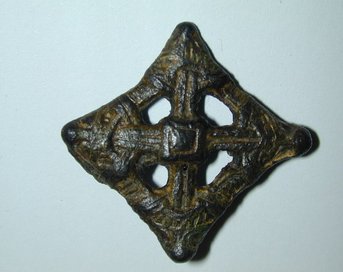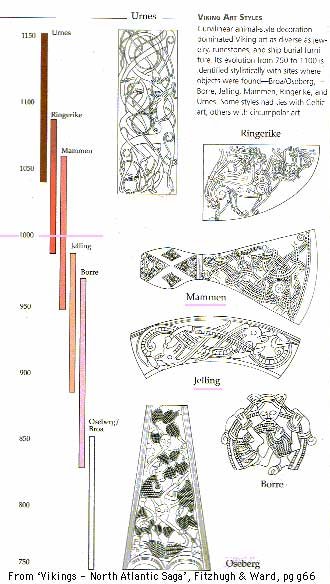Borre National Park in Norway - and the Borre style within a lozenge brooch.
A few years ago I was travelling in Norway, more specific the area around Oslo, in search of the Viking Age monuments to be seen there. One of the things we visited was Borre National Park. We were also in a rush to be able to see the museum near the entrance of the park, to see what was to be seen of Viking Age artefacts, excavated there. Sadly, we couldn't make it before 5 PM, and as it was at the turn to March, it wasn't the summer season and the museum was closed already.
The mounds on Borre National Park dates from the Iron Age up to the Viking Age, 600 AD - 900 AD. Surprisingly just only one of the major mounds on the Borre site has been completely excavated, and this happened in 1852. From this excavation hail the marvellous Borre finds. But because of the unskilled excavation of the Ship Mound at Borre a lot of knowledge was lost. It is likely that the Borre finds were originally on a par with the ship graves at Tune and Gokstad. In the 19th century excavations often weren't of the present day standards. As far as my current knowledge goes, finds from Borre can be seen at the Viking Ship House at Bygdøy in Oslo. But.. you have to check that out ..
The majority of the artefacts exhibited stem from the Ship Mound, which was excavated in 1852. In the mound they found an imprint of a ship about 17 to 20 meters long, but no organic traces of the boat remained. The most spectacular finds in the mound consisted of gilded fittings, which would have sat on a horse’s harness, and a horse collar.
Entering Borre Park, I could just be quiet. What the pyramids must be for the Egypts, the mounds has their equal in this park. What a serene place this is.
This environment is so pure. The knowing that most of the mounds had remained untouched adds to the experience. Altough just one mound had been excavated, an attempt was also made by two other mounds by examining via smaller shafts. Charcoal and burnt bones were discovered. Theory is that existing mounds were used too, by installing new graves in the 10th century.
At the time we entered the park, we were the only ones.
In Viking Age art, the Borre style is derived from the art style first recognised in a group of gilt-bronze harness mounts recovered from a ship grave in Borre mound cemetery near the village of Borre, Vestfold, Norway. Borre Style prevailed in Scandinavia from the late 9th through to the late 10th century, a timeframe supported by dendrochronological data supplied from sites with characteristically Borre Style artefacts.
The Borre style has three main elements, the most obvious being the ring-chain motif: a two-stranded plait whose intersections are bound by a ring. Secondly there is a type of gripping beast with a ribbon body whose claws clasp the frame in which it is placed, and finally a backward-looking quadruped with spirals on its hips and a pigtail.
The Borre style is found on jewellery throughout Scandinavia and even as far away as Russia. In England, artefacts have been found with elements of the Borre style. In the so called lozenge brooch (see underlined the link to the blog I wrote about them specifically) it can be found in the four arms wich are terminating in moulded Borre style animal heads.
But not only in England, I have to say: also in England .. These types of brooches are known from Scandinavian also. Found in England, and being not sure if they were moulded in England or were brought in from Scandinavia, Jane Kershaw is calling them Scandinavian-style. The example hereunder was found in Lincolnshire, UK and was purchased by me at the end of last year. As it wasn't incorporated within the earlier blog on lozenge brooches I show it to you here.
Also see for the blog about the Borre style sword chape here.
Underneath the image of the lozenge brooch an image with a brief overview of the Viking art styles within a timeline.
References:
Fitzhugh & Ward, The North Atlantic Saga, see image;
Graham-Campbell J. Viking Art p. 63 - 70 especially image on p. 64 wich shows an image of the gilt bronze mounts from a horse harness found in the ship-burial from Borre;
http://www.visual-arts-cork.com/ancient-art/viking.htm#carvers
http://midgardsenteret.no/en/ - website to Midgard Historical Centre in Borre
Well. I could have been with these stones until after dark, but as my wife wanted to travel on.. well.. I see you again, some day, hogback stones from Gosforth. And if you happen to be there one day, do not forget that monument on the outside...
Further on with the Cumbrian hogbacktour !
In - yes, luckily again in - St. Peter's church in Heysham, there is a truly beautiful hogback stone. The guide told us, it had been studyied by Thor Ewing, a writer, in 2000. in 'Understanding the Heysham hogback' A tenth century sculpted stone monument and its context (link), Thor Ewing tells in detail what he dicovered on the both sides of this hogback stone.
Just being brought in the church as late as the 1970's accompanied with some protest here and there among the church visitors, considered as being a token of old paganism, it had been remarkably nice preserved, and a lot of detail can be seen, still. Truly worthwile a visit.
I had a small debate with the guide in the church if the - zoomorphic, in my opinion - faces on the sides were lions (or hippo's). The guide doubted if the vikings could have known about lions. Well I guess so, concerning the runes on the Ancient Greek lion statue at the Arsenal, Venice. For example. Vikings did travel south..
But when he told me he was doubting the vikings 'discovered' (as the native inhabitants were of course, in the first place) America before Columbus, I decided to rest my case..
One has to know when to start and to end a conversation ..
Just discovered the book in a bookstore written by Geoff Holder - The guide to the mysterious Lake District, I knew there had to be another hogback stone in Lowther, St. Micheal's Church. With a promising image described in the text of 'a naval and a land-based force of shield-bearing vikings above a fish and what might be a coiled sea serpent. On the reverse is a row of female figures with snakes, possibly a representation of the hideous hag Hel'. Wow. If that did not sound as a true pagan promised land ..
Not complaing too much after all we have seen, this visit was the dissapointing one of them all. But if you wife states 'I am happy to have seen them' and I am answering 'Measuring is knowing' and the even more obligate verb 'handling 'if we did not see it at all, we wouldn't have known anything at all of how they were looking' the glass was again half full, at the last day of our journey..
The hogback stone appeared to be just being tolerated within the entrance segment part of the church. As something you never use anymore but you do not throw away - entirely. That sort of feeling emerged when seeing this hogback asylum seekers.. Bed, bath and bread, ás we say in Dutch, but no luxury at all and standing on some outcuts of wood, you would balance the table with at home..
Come on, St. Micheal's Church.. care a bit more of your 'children' !
This hogback stone was moved in the church in 1907. Hogback stones layed partially buried in the churchyard before it was dug up and moved into the church.
The promising depiction of a longship - as certainly can be seen after some studying - see http://vikingminds.co.uk/pages/longship
we have missed !
The stone itself is (157 x 50 x 30 cm) and very worn.
The hogback stones in Cumbria - very diverse in quality, but everyone worth a visit ! Especially on a gloomy day in late October ...
The churches to visit - see photos of resp. St. Andrew's church in Penrith, St. Mary's church in Gosforth, St. Peter's church in Heysham and St. Micheal's church in Lowther.
Did I miss out on another one in Cumbria ? Let me know !
In a next blog I will take you to four - still remaining utterly mysterious- statues 'guarding' the graveyard of St. Andrew's church in Dacre..
For the last blog of October 9th see this link.
References: (as always, links to where the books can be ordered are attached).
Edwards, B.J.N. Vikings in North West England - The artifacts (1998);
Emery, Gordon, CURIOUS CUMBRIA, The Lake District & Beyond: A celebration of Cumbria (2023)
Ewing, T. 'Understanding the Heysham hogback' A tenth century sculpted stone monument and its context ;
Hall, R. Viking Age archaeology in Britain and Ireland (first printed 1990, reprinted with amendments in 1995);
Holder, G. The guide to the mysterious Lake District (2009)
possibly also (as there within the part of Cumbria dealing with Carlisle, the Eden Valley, Barrow-in-Furness, Whitehaven and the west coast is being dealed with)
Holder, G. Paranormal Cumbria (2010)
http://vikingminds.co.uk/pages/longship

